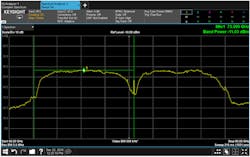5G: How Do You Test for a Standard that Doesn’t Even Exist?
It’s almost here, sort of. The Qualcomm-led 5G New Radio initiative is accelerating through the 3GPP wormhole and should start emerging as a formal specification in two stages in 2018. But how do we test to it in the meantime? Well, I asked the experts at Keysight.
This isn’t a new problem, of course. Designers and developers have been conducting tests on emerging standards for decades: Make an educated guess at what the standard will comprise based on the target market requirements—and which companies are pushing the standard. Odds are high that the key technologies being advocated by the main pushers will be part of the standard. For better or for worse.
However, 5G is different in many ways. Not least of which is that it’s huge. Ginormous, in fact (Fig. 1). It affects everything, from applications like small sensor connections for the IoT to autonomous vehicles, and technologies that include massive MIMO to software defined networking (SDN) and network function virtualization (NFV).
1. The 5G NR initiative has come on strong and fast as the standard of choice for the 3GPP, as it settles on the best way forward to address the needs and challenges of 5G. (Source: Qualcomm)
LTE’s Role in 5G NR
The complexity is why the 5G NR standard was split in two parts: one that’s standalone (SA) and the other that’s, well, non-standalone (NSA). The NSA part will depend on the current LTE radio and core infrastructure as an anchor, while the SA standard will be independent. It gives NSA a head start, but both must converge with an ASN.1 freeze in September 2018.
In the meantime, what are designers to do? I asked Randy Becker, 5G Testbed Program Director at Keysight Technologies, and he pointed out some of the things we already know 5G will use, such as OFDM with the current LTE frame structure. The structure will scale “to handle the diverse requirements of massive machine type communications, as well as increased throughputs for mobile users.”
He elaborated on the specifics of LTE and LTE in NR. For example, LTE is based on a fixed numerology with a 15-kHz (7.5 kHz for large cells) subcarrier spacing, “while NR is based on scaling the LTE 15-kHz subcarrier spacing by 15 kHz * 2n, where n can be negative or positive.” Each component carrier can then have much wider or narrower bandwidths compared to LTE, along with different symbol durations, and subframe durations.
Based on this information, Becker said “it is possible to construct NR-like signals, at the physical layer, that would have approximate signal statistics of a real NR signal when it gets released.”
This is where early trial and (minimal) error comes in. One can gain many insights by using these early NR signals. It helps, for example, when trying to do channel characterization and signal-propagation estimation. Other questions can be answered, too, such as:
- How well can your device under test (DUT) generate/receive narrowband and/or wide-bandwidth signals?
- How does the signal-to-noise ratio (SNR) affect link budget?
- Can your DUT cope with different crest factor signals?
- Is the system amplitude flatness/phase linearity acceptable?
- How do the previously mentioned items change when going from sub-6-GHz to 28 or 39 GHz?
Not too long ago, Becker reminds us that “generating/receiving signals with 20-MHz bandwidths at gigahertz frequencies was considered a black art, but today creating gigahertz signals with modest bandwidths is a commodity.”
Moving to +1-GHz bandwidths at the microwave frequencies brings new challenges that can be addressed today by approximating real 3GPP NR signals, said Becker. “Undoubtedly, NR will have new physical-layer (PHY) channel definitions with different subcarrier allocations, and it will be important to eventually have test equipment capable of generating/analyzing these to evaluate the baseband algorithms in a DUT.”
What Do We Use to Test 5G?
So, there’s much we can do based on early indications of signal types and structures, but what equipment do we use? The obvious answer is to just call Keysight.
2. Keysight’s 5G testbed, which emphasizes high-performance, flexible front-end hardware and software, is an excellent reference point. (Source: Keysight Technologies)
That’s actually a pretty good call to make, as the company has thought this through at length. Even if you don’t end up using their equipment, the testbed its team has put in place is a great reference platform (Fig. 2).
At the heart of Keysight’s formal “5G Testbed” is a software-defined-radio (SDR) system. “It has high-performance RF front ends that can upconvert and downconvert signals from RF to microwave (µW) to millimeter wave (mW) to baseband, and vice versa, with extremely wide bandwidths with excellent fidelity,” said Becker. The signals themselves are generated/analyzed in a powerful software-defined baseband subsystem “that can generate simple 2G and 3G signals, as well as a wide array of 5G candidate waveforms, or completely custom signals for specific projects.”
Keysight has several different and well-known software applications that generate/analyze waveforms for a variety of different technologies. For example, the Keysight SystemVue 5G library can be used to construct and analyze 5G waveforms with customizable parameters to simulate different aspects of a 5G system.
“These signals can be downloaded to a baseband generator or received from a digitizer to turn the hardware into a dedicated 5G test system,” said Becker. The N9041B, for instance, can analyze waveforms all the way from dc to 110 GHz (Fig. 3).
3. The N9041B signal analyzer, one of Keysight’s latest offerings, is very flexible—it covers dc to 110 GHz. Here it’s showing a signal with a bandwidth of 10 GHz around a carrier frequency of 83.5 GHz. (Source: Keysight Technologies)
Finally, Keysight’s Signal Studio software lets you create a wide range of standardized communications signals ranging from GSM to candidate 5G waveforms, which can then be loaded into the baseband generator. In addition, the 89600 VSA software takes digitized waveforms from the hardware and enables demodulation for nearly any type of standards-based signal along with custom signals.
This is a roundabout way of saying: “We know enough to get started, but whichever equipment you end up using, make sure your testbed is flexible and powerful enough to handle whatever the 3GPP will throw at you.” Of course, Keysight isn’t the only test company taking this approach. We’ll discuss National Instruments and others soon.
In the meantime, watch those companies who are actively pushing specific technologies—their efforts can put a curve in any ball, mid-flight. Few expected 5G NR to come on so fast and so strong.




